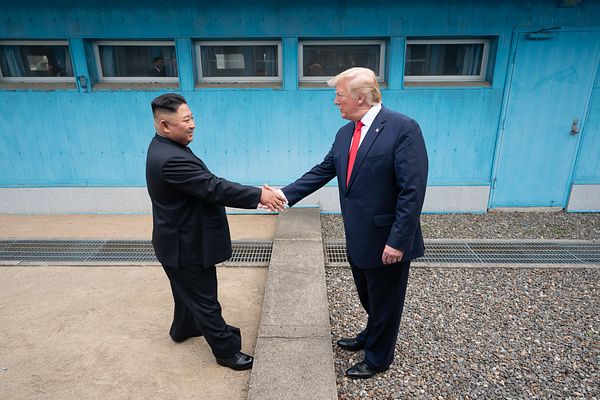The DPRK of 2025 is fundamentally different – and far more dangerous – than when Trump last met Kim Jong Un.
North Korean leader Kim Jong Un and U.S. President Donald Trump shake hands across the line that divides the two Koreas during their last meeting at Panmunjom, June 30, 2019.
U.S. President Donald Trump’s recent declaration that he would “work very hard with Kim Jong Un” to bring peace to the Korean Peninsula felt like an echo from a bygone era. The remark, made upon Trump’s arrival in South Korea in late October for a state visit with President Lee Jae-myung, confirmed that a reunion with Kim was not logistically possible during the trip.
Yet the pageantry surrounding the Lee-Trump summit – from the conferral of the Grand Order of Mugunghwa to praise for Trump’s “wonderful skills as a peacemaker” – recalled the high-stakes theater of 2018 and 2019. That period of personal outreach briefly redefined the global perception of North Korea-U.S. relations.
But the Korean Peninsula of 2025 bears little resemblance to that earlier moment. In the intervening years, Pyongyang has constitutionally codified itself as a nuclear-armed state, deepened strategic cooperation with Russia, and tightened ideological control at home. Kim Jong Un’s nuclear deterrent is no longer a bargaining chip but the constitutional foundation and non-negotiable guarantor of his regime’s legitimacy. For Trump, pursuing “peace” on this new terrain means engaging a North Korea that regards denuclearization not as a negotiable objective but as a direct threat to its sovereignty.
Trump’s renewed talk of reconciliation, therefore, underscores the widening gap between political nostalgia and geopolitical reality. His appeal to peacemaking now unfolds in the shadow of a North Korea that has institutionalized the very nuclear capability Washington once sought to trade away. While the image of summitry remains powerful – handshakes, border crossings, symbolic gestures – the substance beneath it has hardened into strategic perma
Continue Reading on The Diplomat
This preview shows approximately 15% of the article. Read the full story on the publisher's website to support quality journalism.
